10 Best Free & Open Source Status Page Tools

Status pages are a vital tool for any online business in 2025. They provide a modern platform to communicate any incidents or downtime, building trust with your users and saving you time sending emails. The even better news? There are tons of self-hosted, open source and free status page systems to choose from.
At Instatus, we’ve put together the 6 best open source and free status page systems in this article so you don’t have to trawl the internet weighing up your options. First though, let’s take a look at what a self-hosted status page is, the benefits of a free status page over a status page service, and what features the best open source status page should have.
What Is A Self-Hosted Status Page?
When you decide to create a status page for your site, you have two options:
- Get a status page service, like Instatus, to do the hard work for you and set up a beautiful and hosted status page in minutes. (Spoiler alert: Instatus offers a free status page too).
- Use an open source and free status page system to self-host your status page.
Open source means that anyone has the right to use the status page software and its source code for any purpose. That means it’s always free. It also means you host the status page yourself using its source code.
In contrast, using a status page service means the page is built, hosted and maintained for you by the provider. Hosted status pages are quick and easy ways to communicate with your users.
Open Source & Free Status Page Vs. Status Page Service
Self-hosting a free open source status page has many benefits:
- It’s free - ideal for projects with little to no budget.
- It’s flexible - you have open access to the source code so you can build and modify it as you want and you aren’t limited to pre-built features, integrations and API endpoints.
- You host it yourself - you can choose which platform.
- Unlimited team members and subscribers - you control all aspects of the status page with the code. It’s worth noting that Instatus also includes unlimited team members and subscribers even with our free status page service.
- You’re supporting the open-source community!
With that said, for some businesses, a status page service, like Instatus, might be better:
- Easy to set up - Especially if you have limited knowledge of coding.
- Support when anything goes wrong.
- Hosted and maintained externally - This means if you have an outage (which is the reason you need a status page in the first place), the status page is less likely to be affected.
- Connections to third-party components - status page services offer integrations allowing you to showcase the status of the external services you use.
What To Look For In A Free Status Page?
The best open source and free status page systems allow your users to quickly and easily digest any issues (planned or otherwise) affecting your service. Look for open source code for a self-hosted status page that:
- Provides transparent information on your service status and what you’re doing to fix any issues.
- Monitors service status automatically but also allows you to schedule planned maintenance and update your status manually.
- Showcases your historic uptime metrics to demonstrate SLAs.
- Can be used to send subscriber alerts via different communications tools to notify users of problems.
- Allows you to create components to show the service status of different parts of your site.
If you want to create a new status page for your project or company, and you want it to be open-source and free to use, I’ve just chosen the best ones for you.
13. Uptime Kuma
Uptime Kuma is a free and easy-to-use open source tool for monitoring uptime and creating status pages. It supports monitoring for various protocols and services including HTTP, TCP, Ping, DNS, Push, Steam Game Server, and Docker Containers.
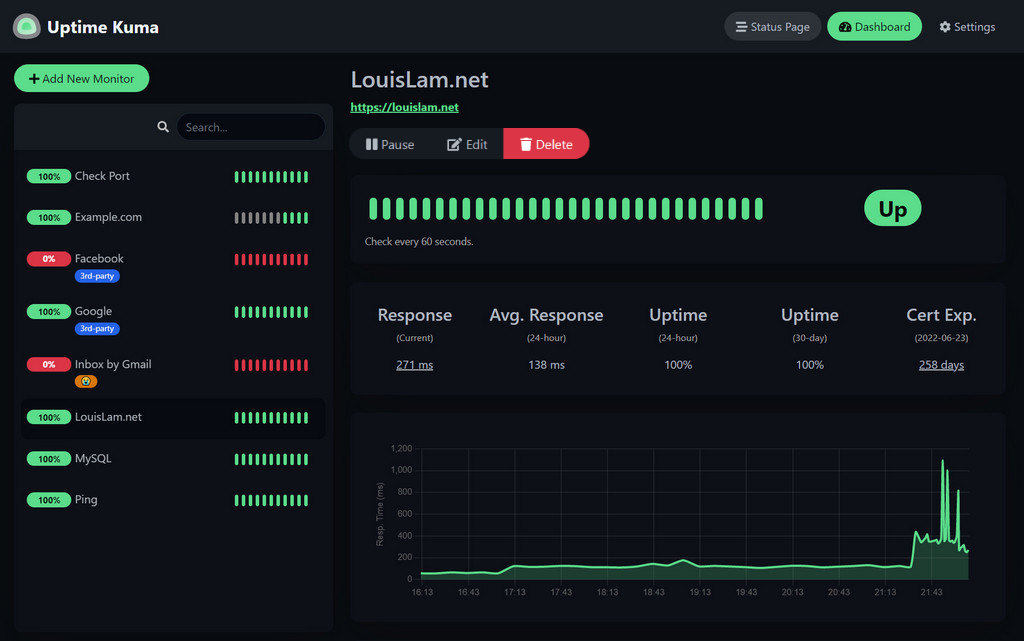
Pros
- It is flexible and can be customized to fit your needs.
- It is scalable and can be used to monitor large numbers of services.
- It is extensible and can be integrated with other tools.
- It has an active community of users and contributors.
Cons
- Not as user-friendly as some other monitoring tools.
- It is not as extensive as some other monitoring tools.
12. Statping
Statping provides status announcements in different colors, dedicated charts for each monitored site, and built-in notifiers such as Slack, Discord, Telegram, Webhooks, and email. There is also a hosted option available for those who don’t want to manage their own status page.
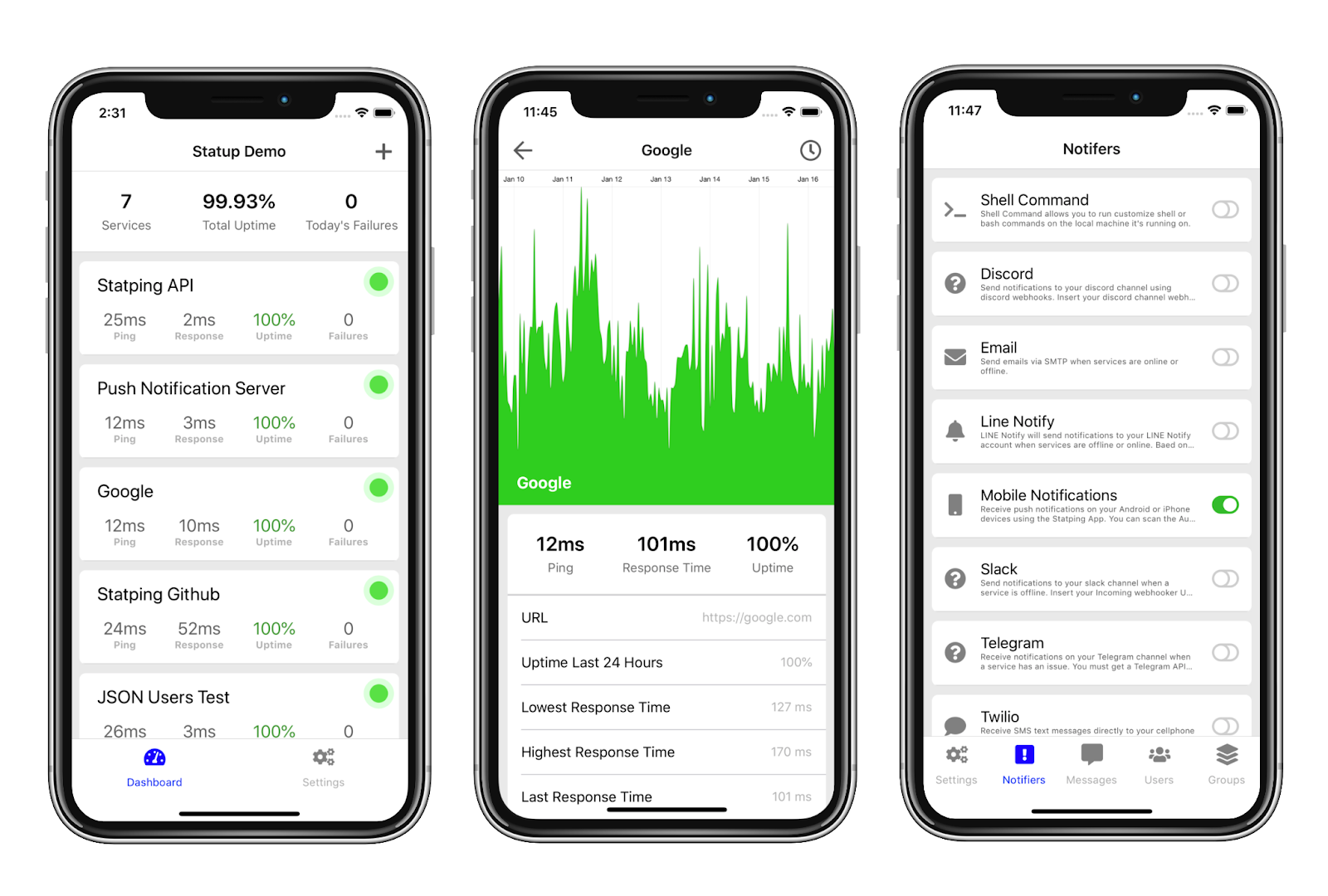
Pros
- Easy to use
- Customizable
- You can monitor as many services as you need.
Cons
- Not as feature-rich as some other monitoring tools
- Has limited integrations with other tools.
- It does not offer phone support.
11. Upptime
Upptime uses a combination of HTTP/HTTPS checks, DNS checks, and ping checks to monitor your services. It also has a feature called "synthetic transactions" that allows you to simulate real user visits to your websites.Upptime can send you alerts if any of your services go down. You can choose to receive alerts via email, SMS, or webhook.
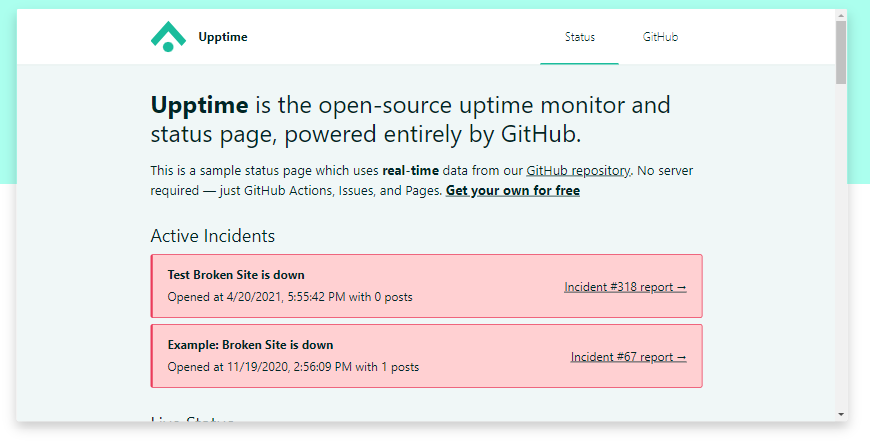
Pros
- You can create a new monitor in just a few clicks.
- You can choose the frequency of checks, the types of checks, and the alerts that you want to receive.
- You can monitor as many services as you need.**
Cons
- Not as feature-rich as some other monitoring tools:
- Has limited integrations with other tools.
10. Vigil
Vigil is a free and open-source status monitoring system. It is designed to be simple to use and to be able to monitor a wide range of services. Vigil can be used to monitor websites, APIs, and other services. It is a command-line tool, so you can use it to monitor your services from the comfort of your terminal.
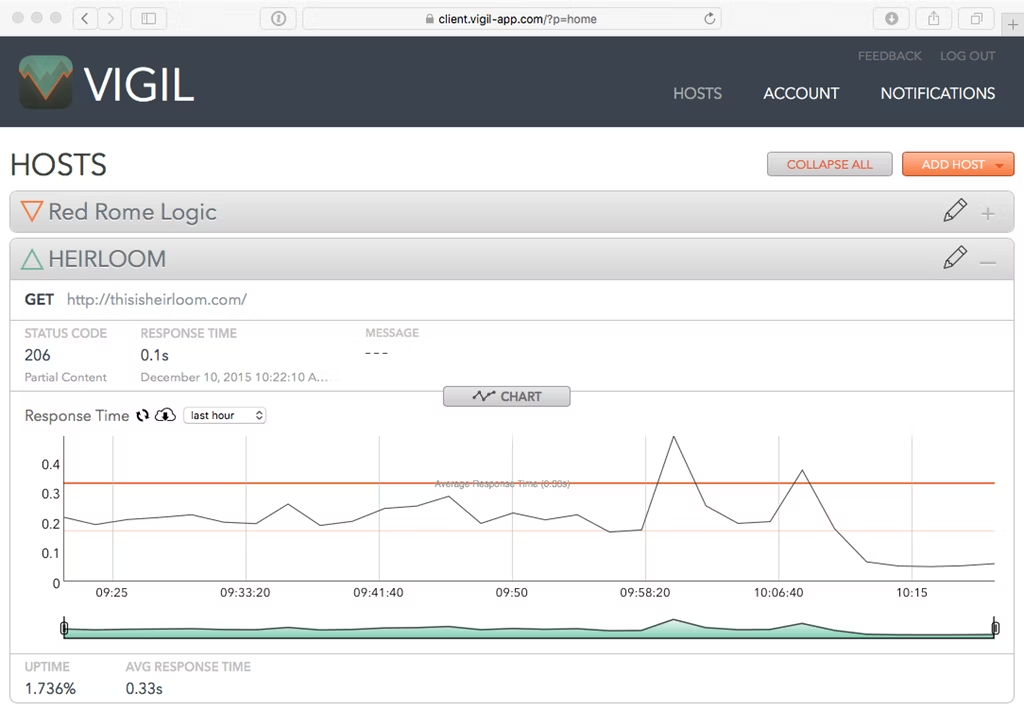
Pros
- Simple to use
- Flexible
- Free and open-source
- Community support
Cons
- It does not have as many features for alerting and notifications.
- Can be difficult to set up if you are not familiar with command-line tools.
- Not as well-documented as some commercial monitoring tools
9. Freshstatus
Freshstatus helps you keep your customers informed about the status of your products and services. It is a cloud-based service that you can use to create a public-facing status page, send notifications to your customers, and track incidents and outages.
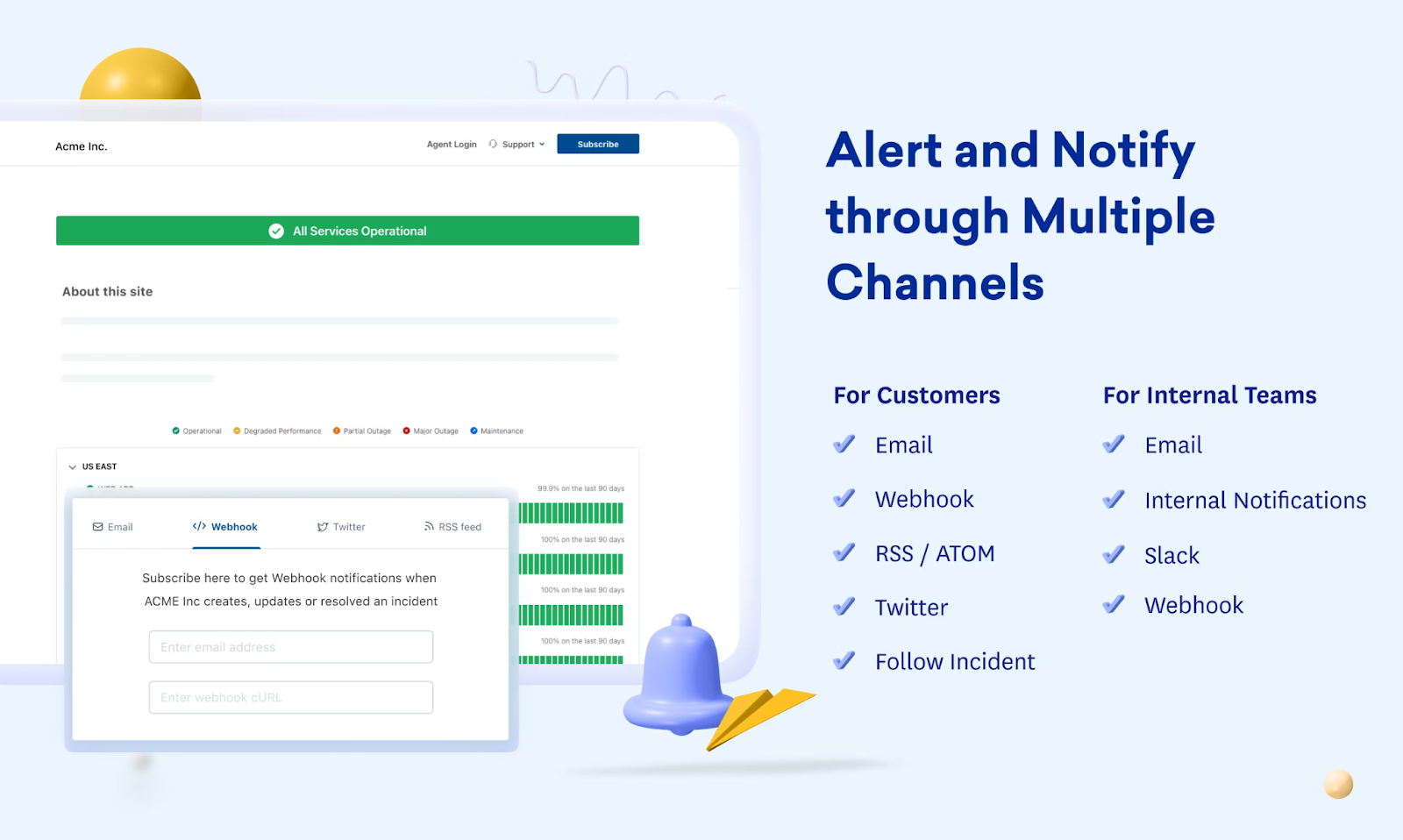
Pros
- Customization level, ability to remove the “subscribe” button
- Free plan available for small businesses
- Integration with FreshPing and FreshStatus
- Use of webhooks for system reporting**
Cons
- Page builder does not auto-save progress
- Occasional errors on the site that require starting over
- Can be difficult to use, especially during incidents or under stress
8. Atlassian Statuspage
Atlassian Statuspage is a status monitoring service that provides a single source of truth for your team and your customers about the status of your services. It's a way to communicate about any incidents or outages that are affecting your services, and to keep your customers updated on the progress of any ongoing issues.
Pros
- It offers a rich assortment of integrations with other services.
- Easy to use and simple to set up.
Cons
- It's not open-source, but it has a limited free plan.
- Lack of built-in monitoring in the product.
- There were some previous issues with the widget, but it has been updated.
7. Cronitor
Cronitor is a monitoring service that keeps track of your applications and infrastructure. It monitors uptime, performance, and errors. It uses cron jobs to run checks, which can be simple HTTP requests or complex scripts. If any checks fail, Cronitor sends alerts.
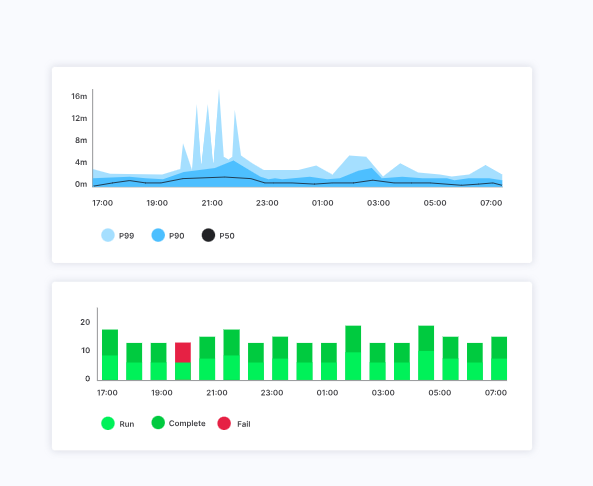
Pros
- Easy-to-use UI
- Quick and simple setup
- Versatile and flexible monitoring
- Helpful customer support
- Integration with different languages
- Monitoring of cron jobs, websites, and APIs
- Alerts for issues and failures**
Cons
- Limited customization of email alerts
- Lack of support for exceptions in scheduled tasks
- Higher pricing for enterprise plans
- Integration issues with WhatsApp and Telegram alerts
- Setup may not be intuitive for some users
6. Better Uptime
Better Uptime is a freemium Status page service that provides incident management and monitoring features. The free plan has some limitations but is sufficient for starting with.
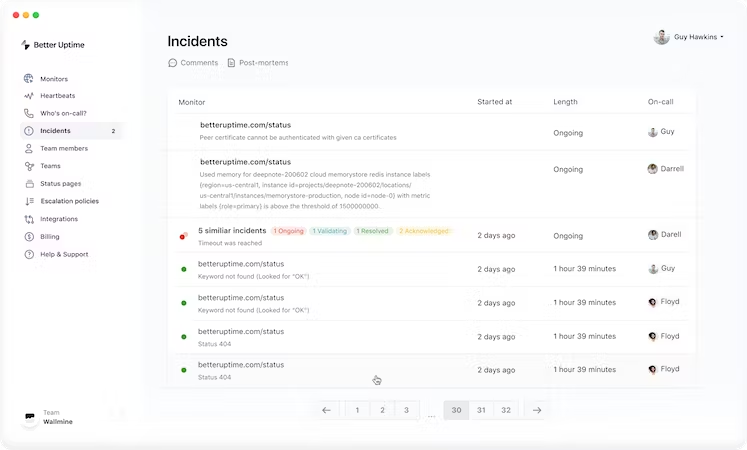
Pros
- Clean and straightforward UX
- Variety of features and customization options
- Email, in-app messages, SMS, and phone call notifications
Cons
- Not open-source, but has a limited free plan
- Inability to have a dashboard with the current status of every monitor on multiple teams
5. LambStatus
LambStatus is a serverless status page system. The idea behind using serverless is that your status page is rarely opened, so you’ll only pay when it is used; not a fixed monthly payment like most other services that require a traditional host.
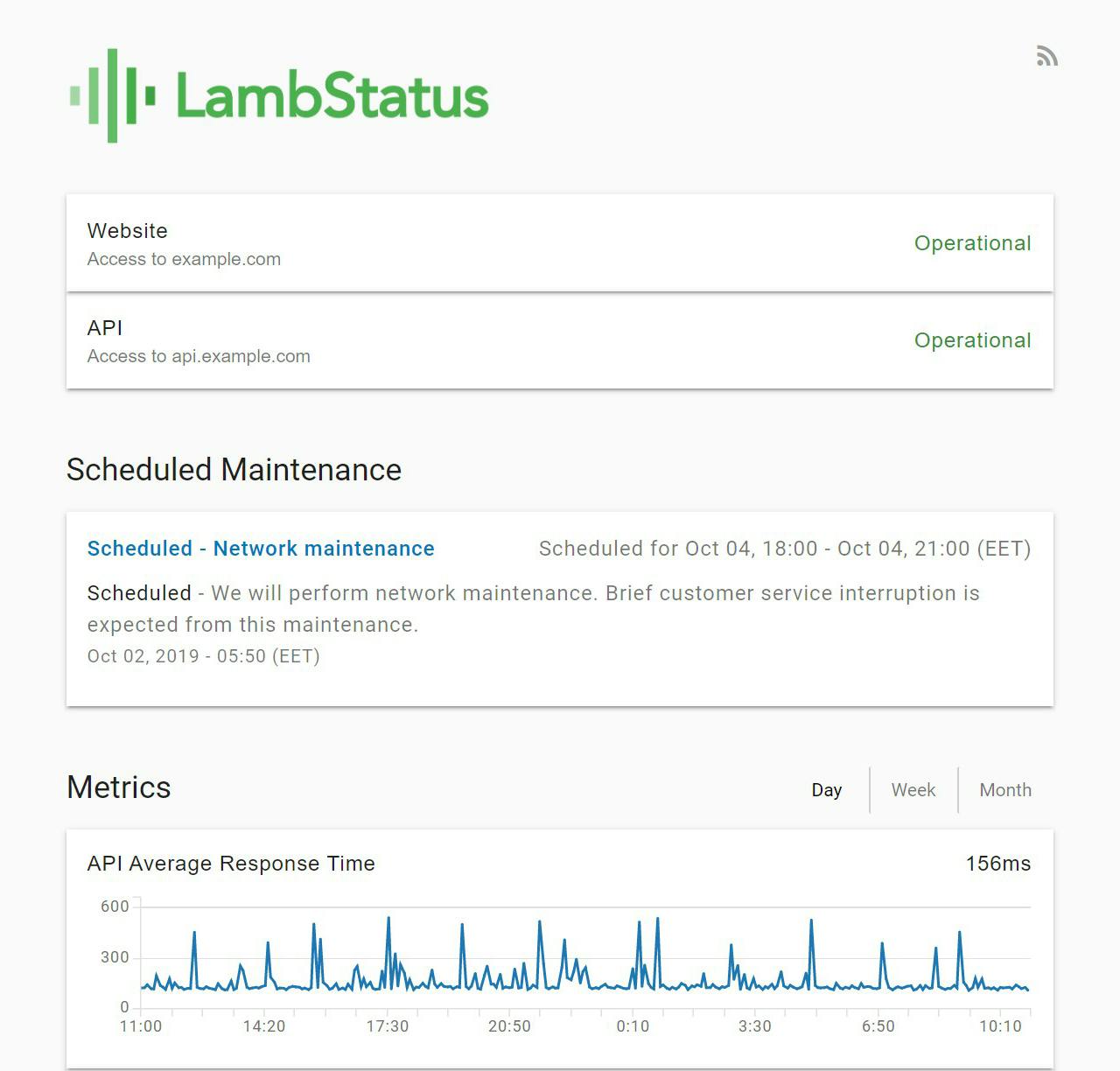
Pros
- Pay for what you use.
- Has a decent admin dashboard.
- You can integrate your metrics.
Cons
- Not the best designed status page; It doesn’t feel modern to me.
- You’re required to host on Amazon AWS. It’s built on AWS services like CloudFormation and Cognito, so you can’t choose another platform.
- Some data load after the page loads. Here is (slowed down) video version of what users see when they open the page.
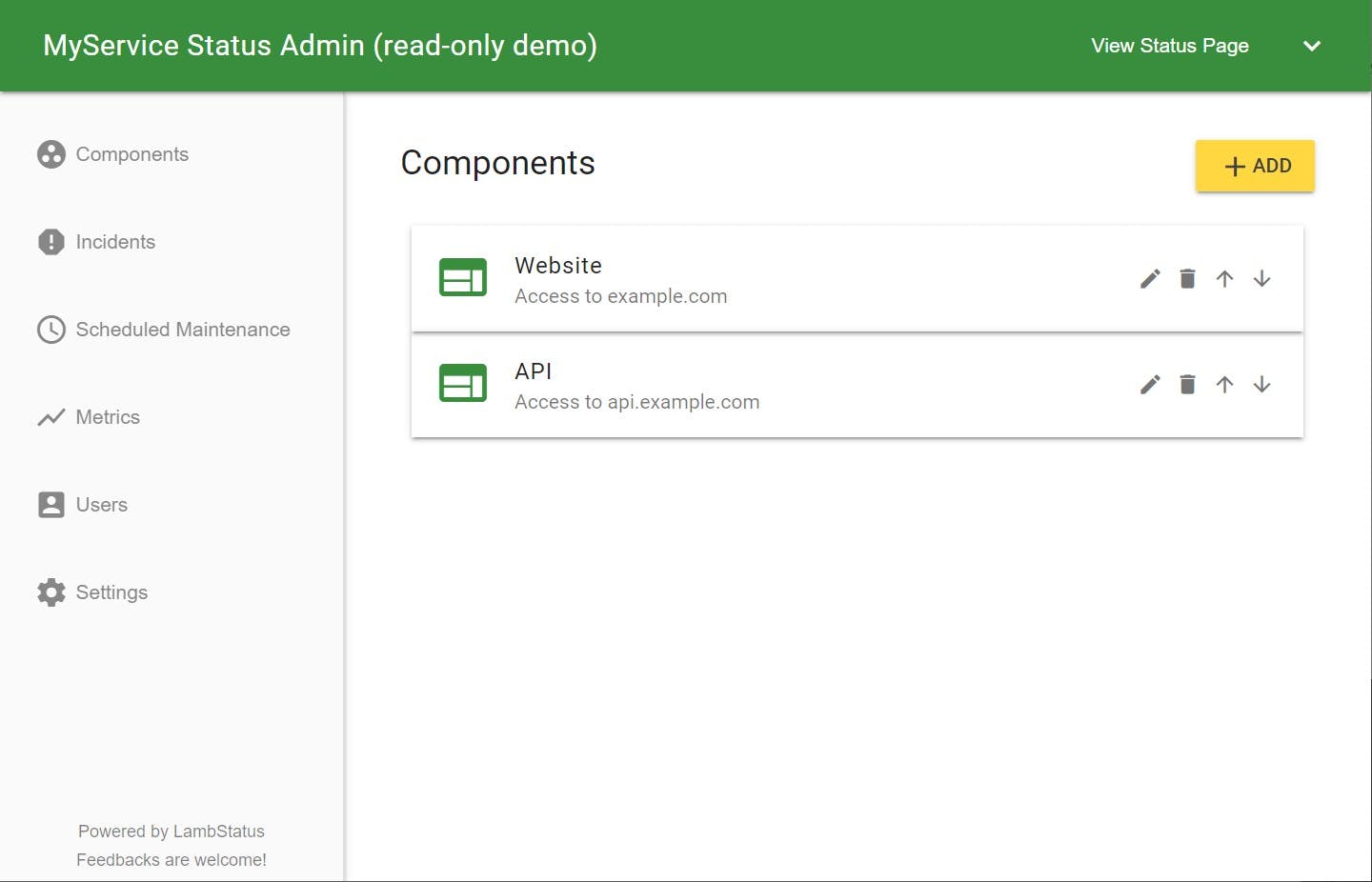
4. Cachet
First version of Cachet was released in 2015, so it’s one the most stable and feature-rich open-source options. However, its status page design feels outdated to me, and also it uses a PHP backend, so it requires a server that’s billed monthly.
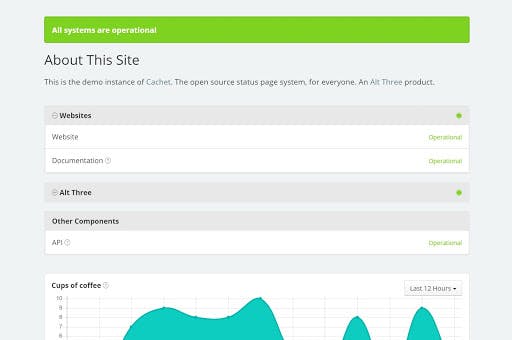
Pros
- Has a good dashboard.
- Can cateogerize components.
- Add your service metrics.
- Accompanying API
Cons
- Not the best designed page.
- Not easy to customize.
- No notifications.
3. Staytus
This is one of the most stable and feature-rich, because like cachet, it’s been there for a long time. Plus, it’s the only one in the list that supports email notifications.

Pros
- Good and clean dashboard.
- Simple design.
- Email notifications.
Cons
- It’s built on Ruby on Rails, so requires a host with monthly payment.
- Incidents details aren’t fully displayed in the status page. Only showed in incident details page.
2. Cstate
Cstate uses a JAM stack. It’s statically generated, which means you can easily host it for free on Netlify or Github Pages. It doesn’t have a dashboard though, so to update you’ll need to update incidents using Github, and your host will auto publish it. Another way is to use Netlify CMS but it requires additional setup.
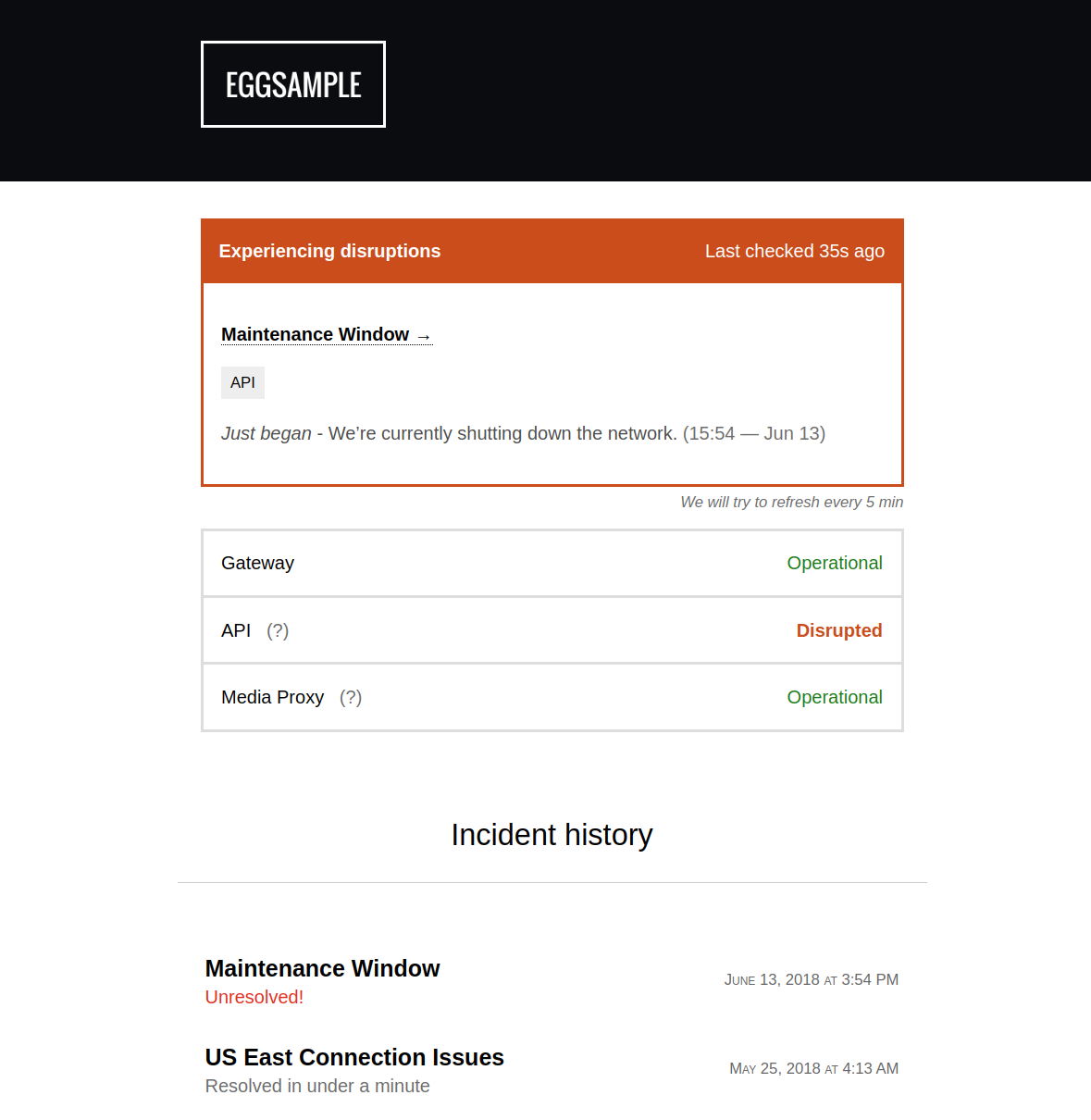
Pros
- Simple and modern design.
- Extremely fast to load.
- Free netlify or Github Pages hosting.
Cons
- No GUI dashboard (but can setup Netlify CMS)
- No API.
- Only RSS notifications.
- Incident details aren’t shown on homepage.
1. Statusfy
Statusfy has all hosting options:
- Statically generate your status page, and host it for free like Cstate.
- Use server rendering it and host it on a regular server.
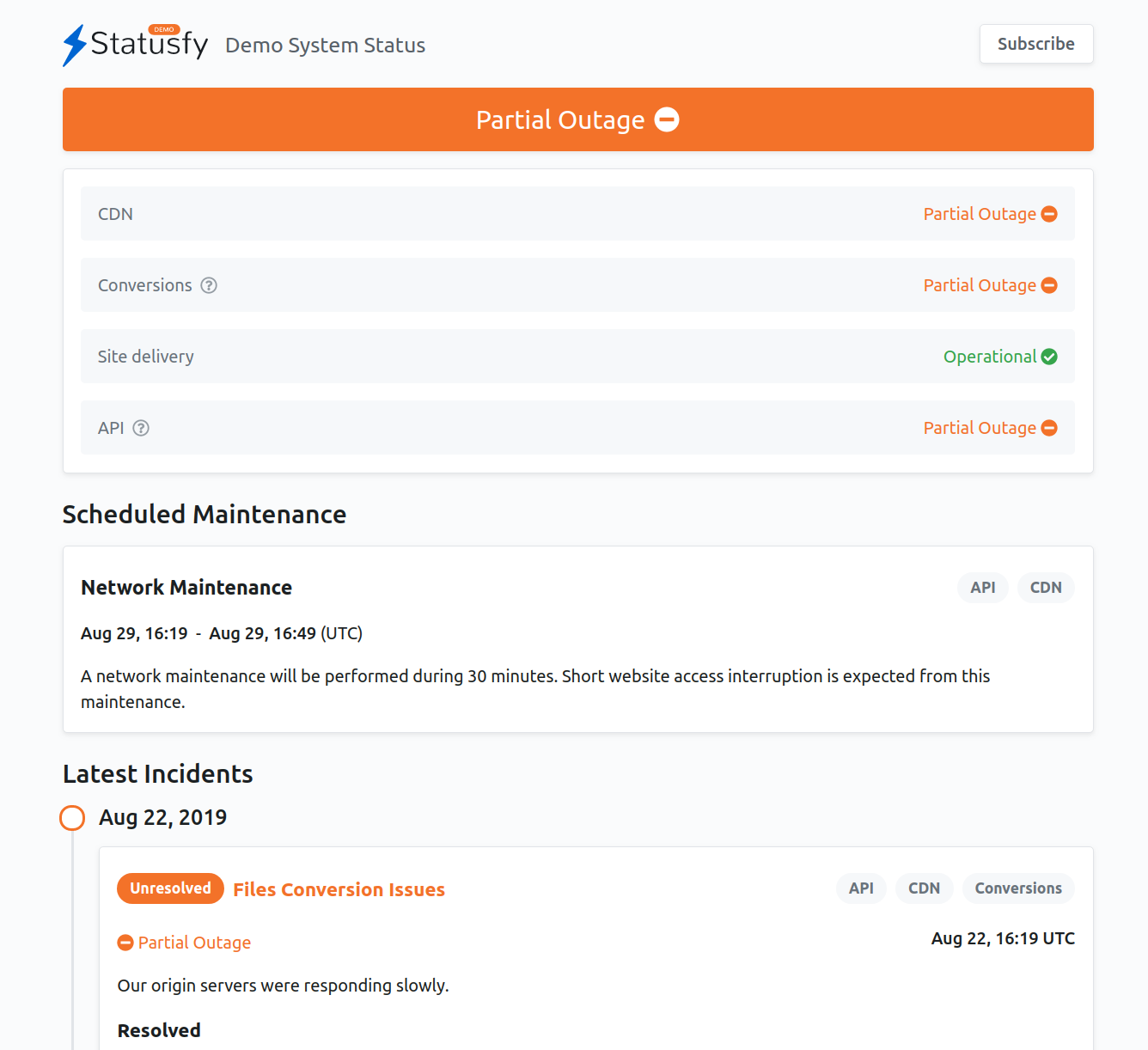
Pros
- Modern design.
- Static generated option for free hosting.
- Has an API.
- Browser, Calendar and RSS notifications.
- Fast to open.
Cons
- No GUI dashboard to add and edit incidents.
- No component categories.
∞. Instatus
Instatus is a hosted status page service that offers a free status page that ticks every box. It’s a great option if you want to save yourself time building an open source status page and let the experts do it instead.
Pros
- Create great-looking, simple and informative status pages for free in just minutes with super-easy setup
- It’s created by an indie developer, you don’t need to worry about signing up for a complex account with a software giant
- Friendly user support and demo requests are handled by the developer, so any questions you have are answered by the person who knows the software best, for no extra cost
- Extensive features and integrations
- Unlimited subscribers and teammates at no extra cost
- Superfast status pages
- Create and categorize components, which your users subscribe to as they pick and choose
- Customizable with CSS and Javascript
- Includes a widget to display your status on your website
- Can be updated with status data from multiple monitoring options
- Custom domain available (with paid Pro subscription)
What’s not to love?
Learn more about why Instatus is the best free status page service.
So there you have it: the 6 best open source and free status page systems out there. Whichever you choose to use, the important thing is that your status page is transparent and informative so you’re building a trustful relationship with your end-users.
Get ready for downtime
Monitor your services
Fix incidents with your team
Share your status with customers


